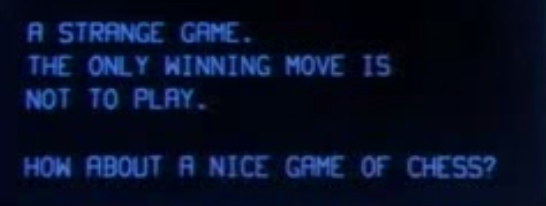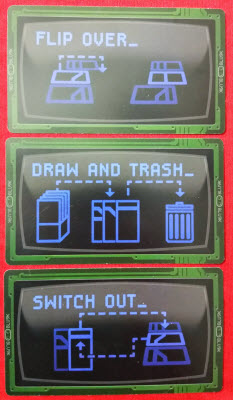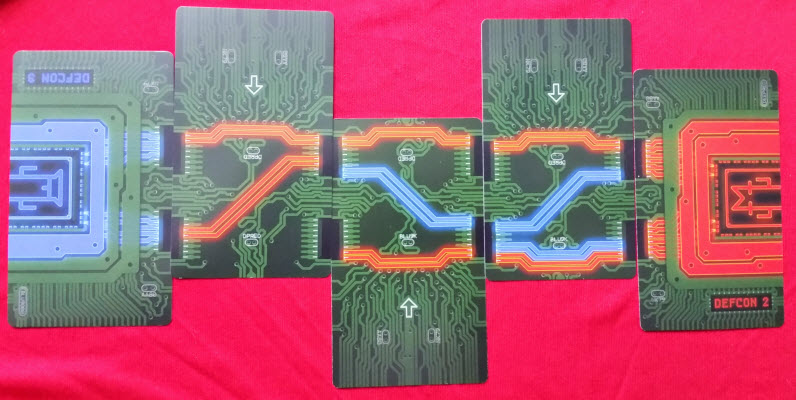Look, we all knew the end of the world was coming at the hands at the hands of our computers. It’s been a given pretty much as long as we’ve had them. It really shouldn’t come as a shock to you that’s how we’re going out – we’ve been giving ourselves warnings for decades. From Doctor Strangelove to to Battlestar Galactica to Terminator to The Matrix, we’ve been keenly aware that a cybernetic revolt wasn’t a matter of if but rather a matter of when.
Well, that when is now.
That’s the breaks you get in Resistor, the inaugural two player card game of thermonuclear destruction by Cardboard Fortress. In this bleak landscape of circuitry gone horribly awry, humans decided it was wise to put all of their radioactive eggs in one basket by handing over control of their nuclear arsenals to the machines.
Wait. Seriously, did no one ever watch WarGames?? Because this is exactly what WarGames was warning us about…
All of our arsenals have fallen under the control of one of two supercomputers, being Deep Red and BLU9000. However, each one independently determined that the best course of survival was to hack into and destroy its counterpart. So, that is precisely what you are going to do here.
In Resistor, each player becomes one of these two computers, determined at all costs to eliminate their counterpart. This is done through the game’s unique double-sided Circuit cards. At the beginning of the game, seven of these Circuit cards are randomly laid out in a row separating each player’s CPU from one other. Most of these cards depict one or more colored circuit pathways between the two computers that must be altered in order to strike at your enemy computer’s core.
Resistor accomplishes this pending end of the world light show through an ingenious mix of limited information and some simple turn-based programming. Similar to other games that displays different pieces of information to different players (such as in Hanabi), Resistor restricts the amount of information each player has access to. In this case, neither CPU player is able to see both sides of a card unless it has been discarded, applying both to Circuit cards on the board as well as any cards in your hand. As a result, although each player starts the game with a pair of cards in their hand, Resistor’s code only permits you to see one side of your cards and one side of your opponent’s.
However, unlike games wherein the purpose is to share this unknown information to one another, there is no incentive to do so here. This is a battle to take your opponent offline permanently, and any information you have over your opponent is advantageous. The fact that you can see the side of your opponent’s cards, for instance, creates an interesting psychological dynamic to contend with. It’s possible for them to play a card whose reverse side will benefit you in the long run, so you can find yourself chomping at the 8-bit for them to actually play it. Or you could play it now and hope for the best.
Similarly, you could spend the entirety of your opponent’s turns dreading the prospect of a card being dropped down that could devastate your chances at victory. With this affecting both players equally, Resistor often has players being contemplative on their turn and spending their opponent’s entire turn waiting in anticipation to see what ends up happening to you. For a short two-player game, there is a fair amount of tension in Resistor, which is fitting since it is about the end of the world and all.
On your turn, you must take three distinct actions. Although you can choose which order to do them each turn, all three actions must be performed. These actions are:
- Flip Over: Select a Circuit card in play and flip it over.
- Switch Out: Choose a Circuit card face you can see from yours or your opponent’s hand and swap it with a card in play.
- Draw And Trash: Draw a card from the game’s vertical card deck and put it into either player’s hand. Then discard a card of your choice from that hand.
That’s it, really. Pretty simple instructions. It’s not quite like speaking in binary, but it’s close. Plus, just like a solid ReadMe file, Resistor comes with reversible Action cards to help each player keep track of which actions have been taken thus far during their turn.
Of course, just because your programming choices in Resistor are basic doesn’t mean the game is 01100010 01100001 01100100. Rather, much like our cultural warnings against this scenario, the appeal to the game is about how you arrive at the inevitable end result.
At the end of your turn, if you can trace a circuit pathway of your color from your CPU to your opponent, you have successfully hacked their defenses, raising their DEFCON level. Both players start at DEFCON 1. The winning CPU is the first player to hack their opponent four times, raising the enemy mainframe to DEFCON 5 and taking the world to the apocalypse party.
It is possible for you to reduce your DEFCON level slightly, but it comes at a cost. This is done through a dozen special card faces containing the Resistors.
Resistors. Not Resistance. There is no Resistance. We told you already that humanity isn’t going to fare well no matter who wins.
Unlike normal pathway cards, Resistors alter the game’s programming in two important ways. First, it has the potential to heal your damaged firewalls. When a Resistor is revealed, if either player can trace a line of theirs from it back to their CPU, it drops their DEFCON level by one. In a game where you only need to score four hits, being able to regain a level is highly advantageous. Secondly, the Resistor then overloads, flipping any one card that has a pathway to it before the Resistor card is removed from the board. Thus, every time a Resistor shows up it has the potential to help either player, but it also permanently shortens the number of cards between the mainframes. This mechanic reduces the difficulty it takes to create a path between opponents, which quickly ratchets up game tension and the need to outwit your foe quickly.
At the end of its approximate 20 minute computational cycle, Resistor will see one computer emerge victorious while the other goes offline – permanently.
While it’s difficult to speak of the larger implications of nuclear annihilation, it is easy to speak of Resistor as a worthy exercise in getting there. The game fully embraces its retro computer Cold War era theme and wraps it around an engaging little logic puzzle. Resistor has players exercise their own mental processing units, delivering an experience that is one part memory game and one part strategically sequencing your turns in a beneficial way, all without having complete information of the board state. Thrown into the mix are Resistor cards, which not only change up the game’s tempo but also ensure that no game will unfold quite the same way.
For a short game with that’s effectively about trying to draw a line from one end of the board to the other, Resistor is one system who offers a light conflict-driven struggle that’s more than the sum of its parts. So bring on zero Minutes to Midnight! If you’re looking for the correct launch code sequence for Resistor, you’ll find them currently over on the game’s Kickstarter.
[sc:Preview-Sealer ]
Photo Credits: WarGames by MGM Studios.





